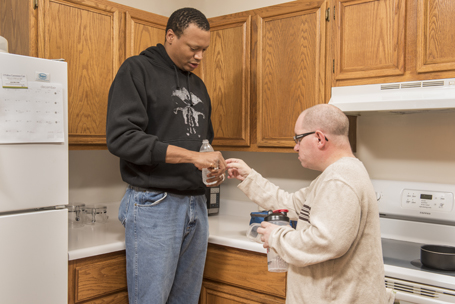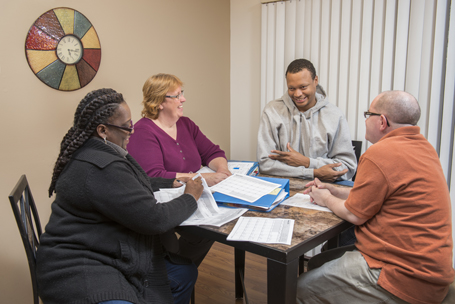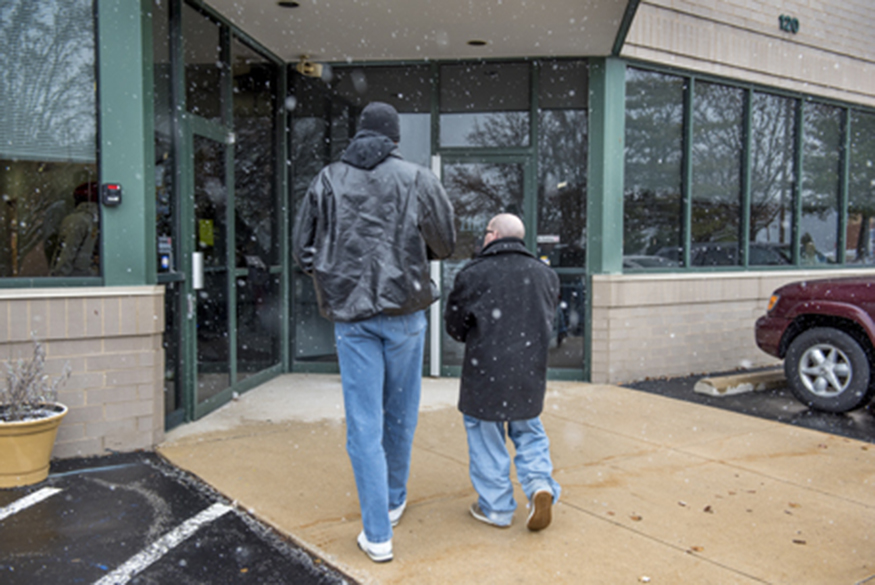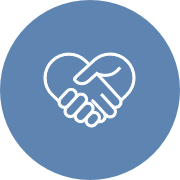
A Shared Life
Todd Davis is having “one of those mornings,” as he calls them, when the chemotherapy hits him particularly hard. Todd is an RHD staffer living with Brandon, a client with autism, in RHD’s companion model of service. They’re supposed to have breakfast, but Todd’s stomach won’t allow it. He excuses himself and makes it to the bathroom.
On his knees, throwing up, Todd feels a hand on his shoulder. Brandon is patting his back. Brandon helps him to the couch, goes to the kitchen, wets a washcloth and brings it in.
“For your head,” Brandon said.
They sit for a moment, and Brandon puts his hand on Todd’s shoulder.
“It’s going to be OK, Todd.”
And that’s how Brandon discovered that his friend and caregiver was sick with terminal cancer, and how Brandon made the extraordinary decision to start helping Todd as best he could, and how Brandon and Todd committed to walking through this journey together.
 In RHD’s companion model, the people RHD supports reside in their own home with a live-in caregiver chosen by the client and their family. The companion assists with daily activities as necessary, and takes part in social and recreational activities. The consumer gains the stability and independence of living in one’s own home, and ideally builds a relationship that comes from working together with a companion to achieve a mutually satisfying home life.
In RHD’s companion model, the people RHD supports reside in their own home with a live-in caregiver chosen by the client and their family. The companion assists with daily activities as necessary, and takes part in social and recreational activities. The consumer gains the stability and independence of living in one’s own home, and ideally builds a relationship that comes from working together with a companion to achieve a mutually satisfying home life.
“The unique thing about the companion model is that support is two dimensional rather than one dimensional,” said RHD Regional Development Director Noal Presley. “In traditional support models, you think about the support somebody receives, but you don’t think about what the staff person is receiving from the individual. The cool thing about this model is that it can capture that — two people from different walks of life, and when you make a good match between them, they share their home and share their life.”
Which brings us to Brandon and Todd. Todd is 5-foot-2 and comes from a background very different from Brandon, who is 6-foot-8. On the surface, they might seem an odd match. But they made a human connection at RHD.
Dennis Yarbrough, the residential unit director at RHD Missouri/St. Louis, matches companions to RHD clients. He was looking for a companion for Brandon when Todd applied.
“Yeah, I was looking for somebody … taller,” Yarbrough said.
“When I put Todd and Brandon together, in my mind, I wasn’t sure what the match was going to be,” Yarbrough said. “Physically, they’re so different. It was kind of Mutt and Jeff when they met each other. But they just gelled together.”
Brandon came to RHD from a group home, where he struggled. He would sleep at night not in his bed, but curled up by the door so that no one could get into his room. He took up skateboarding (and now boasts a collection of more than 60 skateboards) as a way of escaping; he just wanted to get out.
“Brandon would write me letters,” said Sandy Paul, Brandon’s case manager at the Missouri Developmental Disabilities Resource Board. “They were his hopes and dreams, his plans for the future. And they all started the same way: I want a house. I want to live on my own.
“When he moved into the home with Todd, it was a phenomenal thing for Brandon. Phenomenal. Brandon is so much more calm, so much more social. His communication skills have greatly improved, and it’s because he has the opportunity to voice his opinion and to advocate for what he wants. The experience has been wonderful for Brandon.”
When Brandon and Todd first started shopping to decorate their new home, they’d go to a store and Todd would ask Brandon to pick out what he wanted for a wall. Brandon would stand and stare for a long time, not saying anything, and Todd kept saying: “Which one do you like?” Finally Brandon looked down at him and said: “No one ever asked me that before.”
“My goal from the beginning was for him to have a say,” Todd said. “He definitely wanted a change from where he was living. His life did not make sense to him; he wasn’t comfortable there. If you’re going to live anywhere, you ought to feel comfortable and safe. You should feel at home in your home. So he had a voice in what was going on — because that’s what roommates do. It’s a give-and-take situation, and it was from the very beginning.
“We hit it off right away. He told me his goals and his dreams. I told him we could make them happen. We just kind of fell right together. Like magic.”
Brandon occasionally struggles to be understood, but when he talks about Todd his voice is strong and clear.
“I love Todd,” Brandon said. “Todd is my friend. I like to see Todd every day. Every day.”
Brandon alerted the staff at RHD Missouri that something was wrong with his friend. But Brandon’s mother, Neva, had insisted that the staff not share the severity of Todd’s illness with Brandon. She feared it would upset him.
“Todd’s not eating,” Brandon said. “Todd doesn’t feel good.”
Todd played it off as a case of the flu. He had to have a picc line (peripherally inserted central catheter, used to give chemotherapy and other medicines) put in, and doctors strongly recommended that it go in Todd’s arm. Afraid Brandon would see it, Todd insisted that it be placed in his ankle — the most difficult placement and the most painful.
“One thing I told Brandon is that I would always be honest with him,” Todd said. “If he saw a bandage he’d ask about it, and I didn’t want to lie to him. His mother wanted to shield him from this as long as possible, so … it was uncomfortable, but that was the way it was going to be.”
When Todd’s hair started falling out from the chemo, he decided to shave his head after Brandon went to sleep. The next morning, Brandon’s eyes went wide and he said: “Todd! No hair!” Todd just smiled and told him it was a new style.
Eventually Brandon figured it out. The flu didn’t go away. Brandon asked his mother what to do. She told him that Todd just didn’t feel good. Be nice to him. Maybe do some more chores around the house. Help out where you can.
Brandon began rising earlier in the morning so he could greet Todd. He cooks his own meals. He cleans the kitchen. He takes out the trash. He began caring for his caregiver, in any way that he could.
“There are some mornings I feel pretty bad,” Todd said. “And when I’m feeling down, there he is, with a big smile, saying: Good morning! How did you sleep? It’s going to be a great day!
“It touched my heart, the thought he puts into doing those things — genuine acts of kindness, acts of caring. When I’m having a bad day, I know he’s going to be there, with the joy and enthusiasm that he has, showing you that he’s happy and healthy. That gives me strength, to know that he’s being taken care of. As long as I’m doing that, as long as I’m not letting that slide, I feel like I’m still accomplishing something.”
 After a career in insurance and financial planning, Todd was looking for a change of scenery when he applied to RHD.
After a career in insurance and financial planning, Todd was looking for a change of scenery when he applied to RHD.
“I wanted my work to have some meaning,” Todd said. “To make a difference in someone’s life, to watch them grow, that is a profound thing. Brandon is doing things he’s never done before, and he’s proud — he has a sense that he’s accomplishing something, that he’s progressing. We’re making a difference in people’s lives here. We are living up to what we promise we’ll do for our clients. I know a lot of places say that, but at RHD we really do put supports in place to help people be successful and make people’s dreams a reality.
“It’s a good feeling to know that he trusts me enough to let down some of his guards. We’re genuinely friends and roommates, creating a life together that helps him accomplish his goals and dreams. And it’s helping me do that, too.”
Brandon’s mother Neva is heavily involved in Brandon’s care. Neva fell and broke her shoulder last year, and Todd and Brandon drove her back and forth to the hospital, did the shopping, cleaned the house. Todd made it possible for Brandon to care for his mother.
“Well, that’s what you’re supposed to do,” Todd said. “Mom looks out for you, but sometimes you’ve got to look out for mom. Brandon was so proud of what he’d done, and she was proud of him. It strengthened their relationship.
“I don’t take that lightly; that’s something very special, that somebody trusts you to take care of their child.”
Paul put it this way: “When you work providing services for people, the way it has worked for Brandon and Todd is what you hope for.”
“There has to be a relationship for this model to work; there has to be a connection,” Presley said. “Brandon and Todd embody that. They’re the perfect example of why it works. The challenges grow daily for us to preserve this model. But this is why it’s important to continue it.
“Shared living can be complicated. It’s two people living together, sharing a home, sharing a life. If you ask Todd, he’ll tell you this is a way of life, not a job. Yeah, he gets a paycheck, and room and board — general reminders that this is a job. But I think Todd feels like this is his life, him and Brandon.”
Brandon’s life is full. He attends the day program at RHD’s Blank Canvas Studios, where he paints and draws and still writes letters in a unique kind of calligraphy. But now they’re more about how happy he is, how great his life is. Now they’re full of hope.
“It’s a source of comfort that he’s not stalemated because of my illness,” Todd said. “I thought it was important not to worry Brandon. I didn’t want to be somebody who brought stress into his life, and be something upsetting to him. I didn’t want my mess to carry over and be his mess.
“Brandon has been an awesome guy through all this. He’s very kind, and compassionate. Brandon is very caring.”
Brandon was raised in a very religious home, and he’s carried that into his own home. Each night before going to bed, Brandon gets on his knees and says his prayers. One night Todd walks past his room and overhears.
Brandon is praying for him.
 Todd started feeling tired all the time. At first he thought it was trying to keep up with Brandon’s energy, but soon he felt like he was wearing out no matter how much sleep he got.
Todd started feeling tired all the time. At first he thought it was trying to keep up with Brandon’s energy, but soon he felt like he was wearing out no matter how much sleep he got.
“It was different, just bone-weary tired,” Todd said. “They did so many tests, I lost count. After a bone marrow test, they confirmed the diagnosis they suspected, and told me I had MDS, Myelodysplastic Syndrome.
“The first thing they told me was: Do not go home and look this up on the Internet. So the first thing I did was go home and look it up on the Internet. And it was quite scary.”
MDS is a bone marrow disorder in which the bone marrow does not produce enough healthy blood cells.
“Todd sent me a text message telling me he needed to talk,” Yarbrough said. “He said, well, I’m pretty sick. I didn’t know what that meant; he gave me some letters, mds, msd, I don’t even remember what they were. I came back and asked our community nurse — what is this? And she told me … he’s a sick young man.”
Todd’s first concern was Brandon and Brandon’s care. He insisted he could still work, and RHD supported that. Besides, as Todd said: “How can I call in sick? I live there.”
“Todd is doing everything he can to protect Brandon,” Yarbrough said. “He’s not worried about himself. Mostly he was afraid it was going to change their relationship. Life was finally making sense to Brandon; things were going so great. There was never anything wrong at that house. It is the companion model. If I had to draw up a poster child about what shared living is, I would just show them Brandon and Todd.
“There’s not a self-serving bone in Todd’s body. From taking a day off to schedule his chemo time, to making sure Brandon sees his mom, gets to church; he’s re-arranged his medical schedule to care for Brandon.”
RHD worked to make sure Brandon had enough support, given Todd’s medical issues. RHD staffer Jacob Barber works at the house as needed, helping Todd stay on the job.
“The people we support are only as happy, healthy and safe as the people who are supporting them,” Presley said. “If we can’t figure out a situation that works for Todd and helps him through this struggle, that’s going to be reflected in the way he’s supporting Brandon. If ever there was a time when this model made sense, this was it. We knew we had to make sure that we were meeting Brandon and Todd where they were at, and facilitating that relationship to continue despite the challenges that Todd was facing.”
 Their relationship is a striking example of the companion model. Brandon’s social and life skills have seen marked improvement directly because of his friendship with Todd. When Todd was struggling, Brandon became determined to learn the skills he needed to help him.
Their relationship is a striking example of the companion model. Brandon’s social and life skills have seen marked improvement directly because of his friendship with Todd. When Todd was struggling, Brandon became determined to learn the skills he needed to help him.
“Continuity of care, I think, is very important for anybody,” Todd said. “We have established a routine, a rapport, and it was important that things continue as normally as possible. As long as I could do it, I wanted to do it.
“As I’m going through my medical treatments, I think it’s great that RHD put supports in place so that Brandon’s life is not disrupted, and I can get the rest I need to continue to help Brandon accomplish things he wants.”
And so Todd soldiers on, caring for Brandon and walking hand-in-hand with the gentle giant beside him toward a finish line that he refuses to acknowledge. There’s no point to that, after all. There is only the moment, where one life connects to another.
“We’re human services people. There is a passion that we have for people,” Presley said. “We contract with the state of Missouri to make sure Brandon’s needs are met, so we make sure we are doing that. But we also want to nurture a relationship that means so much to Brandon and Todd, and help them walk through this journey together. The disability issue went completely out the door. It became about two people. When one person is down, you go down and pick them up and make them better.
“They’ve inspired me. They make me strive to be a better person, make me strive to be a better director. To see Todd and Brandon benefit from something that I played a part in, it gives me chills.”
“Watching Todd and Brandon, it’s why I do this,” Yarbrough said. “It’s what makes me get up in the morning. The impact on me, I can’t even begin to say. It gets you to the core. It makes me count my blessings every day.
“Just that I can say I put them together — that’s good enough for me.”
Sandy Paul, Brandon’s case manager at the Missouri Developmental Disabilities Resource Board, is an enthusiastic supporter of the companion model. But Paul says she’s never seen anything like this.
“They both gain a lot from each other,” she said. “Brandon has such empathy and compassion, and I think that’s good for Todd. I’m glad Brandon is there for Todd; what Todd is going through, I know that he can deal with it better because he knows Brandon is on his side. Brandon is one of the most loving people I’ve ever met. And he’s growing into such a great, wonderful man who is rising to the occasion to be there for Todd.
“They give me hope. I hope people see what this model can do for an individual, see Brandon and Todd’s unique relationship, and see how they’ve both gotten so much out of it.”
Todd’s hope is that Brandon’s progression will help him gain the ability to keep growing and thriving, even without Todd. But Todd is also hoping that Brandon won’t have to, for at least a little while longer.
“It’s scary,” Todd said. “There are days when I worry more about Brandon than me, and some days when I’m pretty worried about me. My main concern is that if Brandon knows the gravity of it, it would cause him stress and anxiety. I’m afraid that it will be distressing for him. I don’t want him to live in an environment where he’s afraid again.
“Supporting Brandon has been the best experience of my professional life. And I don’t want to go anywhere.”



